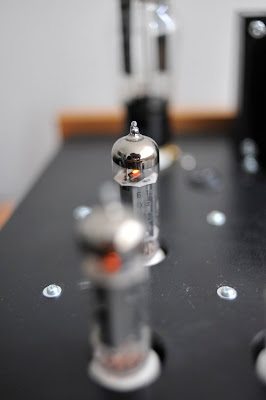After a slight lull due to work commitments, I have finally got around to sourcing the final components for my line-stage, starting to finish off the DRD45 and also getting stuff ready for my Fostex MLTL.
The Line Stage
At the heart of this line stage is the Aikido with 5687 as the output tubes, and as yet unknown input tubes. This will be proceeded by a 100K DACT attenuator, which will itself be proceeded by a DACT switch. The switch will switch both ground and signal of each RCA channel. This should make the potential move to balanced inputs easier.
The reason behind using the Aikido line-stage instead of a passive stage is because of outputs. It allows me to bi-amp, have a tap also for a headphone amp and finally have a tap for a FR output. It may potentially drive all four, but at a minimum, it will drive at least 2 outputs. By using an active line-stage the output signal should be good enough to feed the various power amps. The following are the expected outputs. Output 1 and 4 will be paralleled.
- FR Output - Low 1 Hz First order HP passive filter.
- FR Output - High 150~200 Hz First order HP passive filter.
- Subwoofer Output - 150-200 Hz 3rd/4th order LP active filter.
- Headphone Output - Low 1 Hz First order HP passive filter.
The Aikido requires a RC output, and thus naturally forms a HP filter. Thus, even with the two low 1 Hz options, a RC filter is still required. The following parts value (to limit the size of the cap, to allow for a more economical use of high quality capacitors.). The sub-woofer filter will be some form of OPAMP based 3rd/4th order active filter.
| Frequency |
C |
R |
V-Cap Price |
| 1 Hz |
3.3 uF
|
47 K
|
US$489.99 (250V) |
| 3.3 Hz |
1.0 uF |
47 K |
US$189.99 (300V) |
| 5 Hz |
0.67 uF |
47 K |
US$160.99 (300V) |
| 10 Hz |
0.33 uF |
47 K |
US$114.99 (600V) |
| 150 Hz |
0.022 uF |
47 K |
US$39.99 (600V) |
| 180 Hz |
0.018 uF |
47 K |
n/a |
| 200 Hz |
0.016 uF |
47 K |
US$36.99 (600V) |
Looking at the table above, the 1 Hz point is not practical for premium capacitors, from a cost and voltage rating perspective. A better compromise would be 3.3Hz or 5 Hz. At present, the outstanding items for resolution prior to the ordering of the components are the input tube and the output RC parameters as mentioned above. Changing the R to 100K will effectively half the value of the capacitor, further reducing costs.
The candidates for the input tube are limited in that I want to have a low Rp tube. Leaving 6H30, 6DJ8 and 6N1P. Having a stack of 6N1P/6DJ8 from the Decware amp, that seems to make the most of sense. In particular the 6N1P with higher voltages show incredibly low Rp, 956R at 300V! But by far the most flexible is the 6H30 with average Rp of around 1200 over a range of operating points.
The 12BH7 also entered the equation as I have a Maple Tree Audio Design EAR headphone and line amp that uses the 12BH7 as the line output amp, that I am about to rebuild without the line stage.
The Aikido will be powered by the matching PS-1 Voltage regulator with both HV and LV regulator. This seems an ideal match and in discussion with John, appeared to be a better match for the 5687 with lower voltages and higher currents than the Janus, which he suggested was better for higher voltages and lower currents.
The Aikido kit arrived a few days ago, and I ordered with it, the PS-1 Voltage Regulator kit. All I can say from initial un-boxing, is that the quality of packing, instructions manual/booklet and components are first rate! I do look forward to further unravelling the kit, and expect more photos.
DRD45
The final missing part was the Ultrapath capacitor, in which I invested in a pair of Mundorf M-Tube Cap 100 uF/550VDC. Whether this will be bypassed with a lower value special quality (Teflon, Silver foil, etc) capacitor will remain a future question. I have finally laid out the two monoblocks and marked the cutting plan onto the MDF panels. However, with a recent thumb injury, the machining of this will have to place further down the track.
Fostex MLTL
A pair of Fostex FE-207e was purchased some time ago for a MLTL, that had the original intention of being upgraded later to a Lowther or AER alternative. However, I also wanted to maximise the performance of the 207e. I purchased a pair of Phase Plugs from Planet 10 Hi-Fi. These are unfinished, and I will apply of few coats of Shellac to seal them, which should match the intended enclosures. I also purchased a bottle of Dammar as per Sakuma's advice. However, I will not apply the product until the speakers have had at least 200 hours of burn-in.
At present, the intent is to have the 207e cover from low bass in the 30-40Hz region up to around 10 kHz and then have a ribbon tweeter take over from there to around 40 kHz. The first step is to build the enclosure and test it before the application of a super-tweeter.














